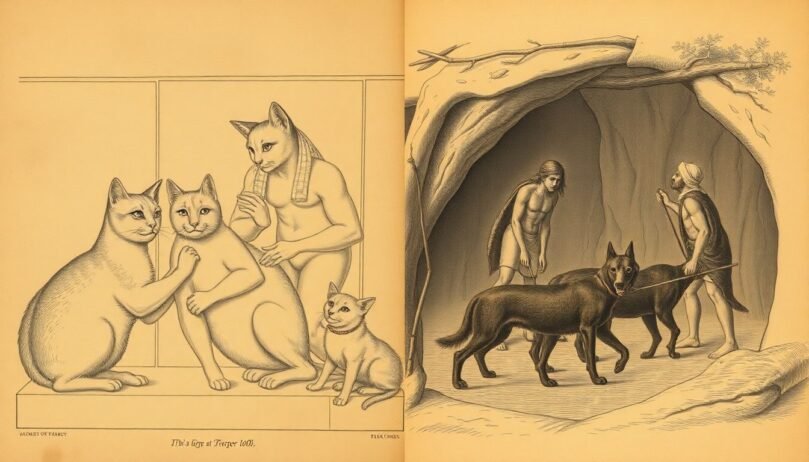The History Of Cats & Dogs
- 29 February 2024
- BuyAPet Editorial Team
- All Cats, All Dogs, Cats and Dogs
The History Of Cats & Dogs
A quick tour from hunters and guardians to today’s beloved family members.
Overview
The History of Cats and Dogs: A Tail of Two Species
The bond between humans and their furry companions stretches back thousands of years. Cats and dogs have played significant roles in our lives, from hunters to loving pets. Understanding their histories reveals much about our own evolution and the deep connections we share with these animals.
The Enduring Bond: Humans and Animals
Dogs and cats have been part of human life for millennia. They provide companionship, help with hunting, and even assist with farming. This special bond has grown stronger over generations, allowing pets to become integral members of many families.
A Shared History: Parallels and Divergences
While both species have similar roles in human life, their paths of domestication diverge significantly. Dogs have long been seen as loyal aides, while cats tend to be more independent. Yet, both have carved unique spaces in our hearts and homes.
The Ancient History of Dogs: Man's Best Friend
Dogs are often called "man's best friend." Their journey to domestication is marked by various theories and fascinating evidence.
Early Domestication: Theories and Evidence
The process of dog domestication likely began around 15,000 years ago. Early humans may have found benefits in befriending wolves, leading to a gradual transformation into domesticated dogs. Archaeological findings indicate that these companions helped our ancestors hunt and protect their communities.
Ancient Roles: Hunting, Herding, and Companionship
Throughout history, dogs have taken on various roles
Hunting: Early humans used dogs for tracking and hunting animals, making them valuable partners.
Herding: Some breeds were developed specifically to help shepherd and manage livestock.
Companionship: Dogs have been cherished as companions, providing loyalty and friendship.
Ancient Dog Breeds: Tracing Their Ancestry
Several dog breeds date back to ancient times, including
Basenji: Known as the "barkless dog," traced to ancient Egypt.
Saluki: One of the oldest breeds, bred for hunting in the Middle East.
The Enigmatic History of Cats: Independent and Adaptable
Cats have a distinct history filled with myths and unique tales. Their independence has intrigued humans for ages.
Early Domestication: Myths and Realities
Unlike dogs, the domestication of cats likely began around 9,000 years ago in the Near East. It's believed that they were drawn to human settlements to hunt rodents, leading to a mutual benefit that spurred their domestication.
The Rise of Feline Companions: Egypt and Beyond
In ancient Egypt, cats were revered and often worshipped. They were symbols of protection and fertility, and harmed cats faced severe penalties. This deep respect laid the foundation for cats becoming cherished companions worldwide.
Ancient Cat Breeds: A Diverse Lineage
Several ancient breeds have roots in the past
Siamese: Originating in Thailand, known for their striking appearance.
Maine Coon: One of the oldest natural breeds in North America, famed for its size and friendliness.
The Evolution of the Human-Animal Bond
As time passed, our connection with cats and dogs transformed significantly.
Cats and Dogs in Art and Literature
Both animals have inspired countless works of art and literature. From ancient Egyptian murals to modern novels, the bond between humans and these pets has always fascinated artists and writers alike.
The Impact of Science: Understanding Animal Behavior
Recent scientific studies have helped us better understand animal behaviour. We now know pet owners can benefit from the companionship, reducing stress and loneliness.
The Changing Roles of Cats and Dogs
Today, the roles of cats and dogs have expanded
Therapy Animals: Many pets are trained to help people with physical and emotional challenges.
Service Animals: Dogs especially play critical roles in assisting those with disabilities.
Cats and Dogs in the Modern World
In today's society, pets are more than just companions; they are part of the family.
The Pet Industry: A Multi-Billion Dollar Market
The pet industry has exploded into a multi-billion dollar market. With products ranging from gourmet foods to luxury pet services, owners are eager to pamper their furry friends.
Responsible Pet Ownership: Ethical Considerations
With ownership comes responsibility. It's essential to provide care, love, and proper training. Ethical considerations include
Adopting instead of buying: Many animals in shelters need homes.
Spaying/neutering: Helps control the pet population and improves health.
The Future of Companion Animals
The future of cats and dogs looks promising. As we learn more about their needs and behaviours, we can improve their lives and strengthen our bond.
Conclusion: Celebrating Our Furry Friends
The history of dogs and cats is a testament to the deep connection between humans and animals. By understanding their past, we can appreciate their role in our lives even more.
Key Takeaways: Respecting History, Embracing the Present
Dogs and cats have been part of our lives for thousands of years.
Both species have unique, fascinating histories that enrich our understanding.
Responsible ownership is vital for the welfare of these animals.
Actionable Tips: Promoting Responsible Pet Ownership
Consider adopting a pet from a local shelter.
Invest time in training and socialising your pet.
Regular vet visits ensure your companion stays healthy and happy.
By fostering a deeper understanding and respect for our furry friends, we can celebrate their place in our hearts and homes.
FAQs
When were dogs domesticated? +
Estimates vary, with early domestication thousands of years ago—evolving alongside humans.
How did cats join us? +
Likely through mutual benefit—rodent control near grain stores leading to companionship.
Why do myths differ by culture? +
Animals symbolised different values across regions and eras, shaping stories and roles.
Historical timelines are evolving—new discoveries continue to refine the story.
